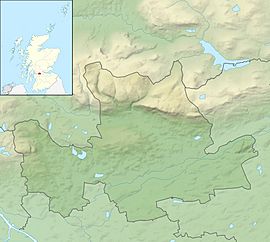Kirkintilloch Castle facts for kids
Quick facts for kids Kirkintilloch Castle |
|
|---|---|
| Kirkintilloch, East Dunbartonshire, Scotland | |
| Coordinates | 55°56′24″N 4°09′40″W / 55.940°N 4.161°W |
| Site information | |
| Condition | Earthworks only |
Kirkintilloch Castle was once a strong castle located in Kirkintilloch, East Dunbartonshire, Scotland. It played a part in important historical events, especially during Scotland's fight for independence. Today, only parts of its original structure remain.
Contents
Kirkintilloch Castle: A Look Back
This castle was built a long time ago, in the 12th century. It was constructed by the powerful Comyn family. The town of Kirkintilloch became a "burgh" in 1211. A burgh was a special type of town that had certain rights and privileges, like holding markets.
Life During Wartime
During the Scottish Wars of Independence, English soldiers used Kirkintilloch Castle. These soldiers were called a "garrison." Their commander was Sir Philip de Moubray.
One important event happened in 1305. The English garrison from the castle was sent to arrest the famous Scottish hero, William Wallace. They took him from Robroyston to Dumbarton Castle.
Later that same year, the soldiers at Kirkintilloch Castle had a problem. They sent a message to King Edward I of England because they weren't getting paid!
A Castle Under Attack
In 1306, a Scottish leader named Bishop Robert Wishart tried to capture the castle. He led a "siege," which means his army surrounded the castle and tried to force the people inside to surrender. However, the siege was not successful.
The next year, in 1307, King Robert the Bruce gave Kirkintilloch to Malcolm Fleming. But by this time, the castle was likely already destroyed and left empty.
The Castle's End
The Fleming family decided not to rebuild Kirkintilloch Castle. Instead, they built their new home at Cumbernauld Castle. Even though the castle was gone, some of its stone walls could still be seen until the 1700s. People then used these stones for other building projects.
What Remains Today
If you visit Peel Park in Kirkintilloch today, you can still see traces of the old castle. What's left is called a "motte." A motte is a large mound of earth where the main part of a castle used to stand.
The motte at Peel Park is shaped like a rectangle. It measures about 30 meters (98 feet) long and 17 meters (56 feet) wide. There's also a ditch on its south and east sides.
Interestingly, the castle was built right on top of the old Roman Antonine Wall, next to a Roman fort. Because of all these historical features, Peel Park is now a special place called a scheduled monument. This means it's protected because it's very important to national history.


